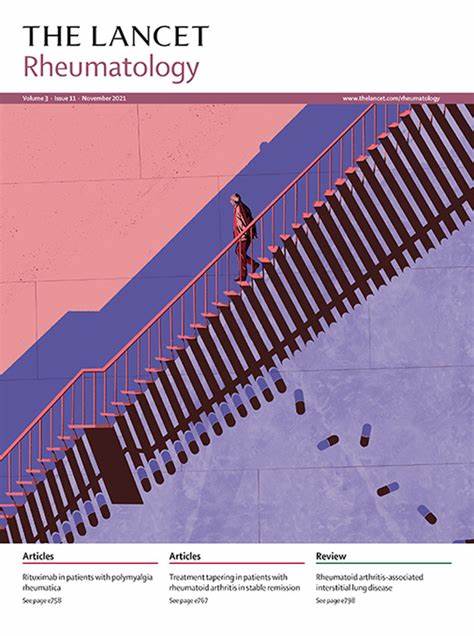The effect of ixekizumab treatment on MRI sacroiliac joint structural lesions in patients with radiographic axial spondyloarthritis: post-hoc analysis of a 52-week, randomised, placebo-controlled trial with an active reference arm
IF 15
1区 医学
Q1 RHEUMATOLOGY
引用次数: 0
Abstract
Background
The effect of biological disease-modifying antirheumatic drugs (DMARDs) on sacroiliac joint lesions over 52 weeks in biological DMARD-naive patients with radiographic axial spondyloarthritis is unknown. This post-hoc analysis evaluated the effect of ixekizumab and adalimumab versus placebo on structural lesions in sacroiliac joints assessed by MRI in patients naive to biological DMARDs with radiographic axial spondyloarthritis from the COAST-V study.
Methods
COAST-V was a phase 3, multicentre, randomised, double-blind, placebo-controlled trial with an active reference arm done over 52 weeks at 84 sites in 12 countries. Eligible patients were adults (aged ≥18 years) naive to biological DMARDs with active radiographic axial spondyloarthritis, radiographic evidence of sacroiliitis, and an inadequate response or intolerance to non-steroidal anti-inflammatory drugs. Patients were randomly assigned (1:1:1:1) to 80 mg ixekizumab every 2 weeks (Q2W) or every 4 weeks (Q4W), 40 mg adalimumab Q2W, or placebo. At week 16, patients receiving placebo or adalimumab were randomly assigned (1:1) again to ixekizumab Q2W or ixekizumab Q4W. Post-hoc analyses of patients with MRI available at baseline, 16 weeks, and 52 weeks are reported. MRIs were scored using the Spondyloarthritis Research Consortium of Canada sacroiliac joint structural scores for erosion, backfill, fat lesions, and ankylosis. ANCOVA was used for treatment comparisons in observed cases adjusting for baseline values, bone marrow oedema, and stratification factors. Subgroup analyses by sex, HLA-B27, and baseline bone marrow oedema were done.
Findings
Between June 20, 2016, and Aug 22, 2017, 341 patients were enrolled in the COAST-V study. MRI scans were available for 325 (95%) of 341 patients at baseline and week 16, and for 301 (88%) patients at week 52. 264 (81%) of 325 patients were male and 61 (19%) were female, and the mean age was 41·5 years (SD 11·6). At week 16, erosion significantly decreased versus placebo in the ixekizumab Q2W group (least squares mean –0·91 [SE 0·19] vs 0·10 [0·18]; p<0·0001) and the ixekizumab Q4W group (–0·57 [SE 0·19]; p=0·0086]); the effect of adalimumab was similar. Backfill significantly increased from baseline to week 16 in ixekizumab Q2W versus placebo (0·52 [0·12] vs 0·04 [0·12]; p=0·0042). At week 16, decreases in erosion differed significantly between the placebo group and ixekizumab Q2W or Q4W groups, and differences were seen by sex, HLA-B27 status, and baseline bone marrow oedema score. At week 52, at both ixekizumab doses, further changes were observed in erosion and backfill, which were greatest with continuous ixekizumab Q2W (mean erosion –1·50 [SD 2·70], mean backfill 0·76 [SD 2·09]). A decrease in erosion was also noted in patients switching from adalimumab to ixekizumab at week 16. COAST-V was registered with ClinicalTrials.gov (NCT02696785).
Interpretation
A decrease in erosion and increase in backfill were observed at week 16 with further reductions in erosion and increases in backfill occurring at week 52 in patients receiving ixekizumab. Ixekizumab, like adalimumab, modifies structural lesions that is consistent with a rapid tissue response in patients with radiographic axial spondyloarthritis. However, the effect on the development of ankylosis in sacroiliac joints or the spine requires further analysis.
Funding
Eli Lilly.
ixekizumab治疗对影像学中轴性脊柱炎患者MRI骶髂关节结构病变的影响:一项52周随机安慰剂对照试验的事后分析。
背景:生物疾病缓解抗风湿药物(DMARDs)对未使用生物DMARDs的轴型脊柱炎患者骶髂关节病变超过52周的影响尚不清楚。这项事后分析评估了ixekizumab和阿达木单抗与安慰剂对骶髂关节结构病变的影响,这些病变是由COAST-V研究中首次出现生物dmard并影像学诊断为轴性脊柱性关节炎的患者进行MRI评估的。方法:COAST-V是一项3期、多中心、随机、双盲、安慰剂对照试验,在12个国家的84个地点进行了52周的有效参考组。符合条件的患者为未接触生物dmard的成人(年龄≥18岁),影像学表现为活动性轴性脊柱炎、骶髂炎,对非甾体类抗炎药反应不足或不耐受。患者被随机分配(1:1:1:1)至每2周80mg ixekizumab (Q2W)或每4周(Q4W), 40mg阿达木单抗Q2W或安慰剂组。在第16周,接受安慰剂或阿达木单抗的患者再次随机分配(1:1)到ixekizumab Q2W或ixekizumab Q4W。报告了基线、16周和52周MRI患者的事后分析。mri采用加拿大脊柱炎研究协会的骶髂关节结构评分对糜烂、回填、脂肪病变和强直进行评分。ANCOVA用于观察病例的治疗比较,调整基线值、骨髓水肿和分层因素。按性别、HLA-B27和基线骨髓水肿进行亚组分析。结果:在2016年6月20日至2017年8月22日期间,341名患者入组了COAST-V研究。在基线和第16周,341例患者中有325例(95%)进行了MRI扫描,在第52周有301例(88%)患者进行了MRI扫描。325例患者中男性264例(81%),女性61例(19%),平均年龄41.5岁(SD 11.6)。在第16周,与安慰剂组相比,ixekizumab Q2W组糜烂显著减少(最小二乘平均值为- 0.91 [SE 0.19]对0.10 [0.18];解释:在接受ixekizumab的患者中,在第16周观察到糜烂减少和回填增加,在第52周发生糜烂进一步减少和回填增加。与阿达木单抗一样,Ixekizumab可以改变结构病变,这与放射成像轴性脊柱炎患者的快速组织反应一致。然而,对骶髂关节或脊柱强直发展的影响需要进一步分析。资金来源:礼来公司。
本文章由计算机程序翻译,如有差异,请以英文原文为准。
求助全文
约1分钟内获得全文
求助全文
来源期刊

Lancet Rheumatology
RHEUMATOLOGY-
CiteScore
34.70
自引率
3.10%
发文量
279
期刊介绍:
The Lancet Rheumatology, an independent journal, is dedicated to publishing content relevant to rheumatology specialists worldwide. It focuses on studies that advance clinical practice, challenge existing norms, and advocate for changes in health policy. The journal covers clinical research, particularly clinical trials, expert reviews, and thought-provoking commentary on the diagnosis, classification, management, and prevention of rheumatic diseases, including arthritis, musculoskeletal disorders, connective tissue diseases, and immune system disorders. Additionally, it publishes high-quality translational studies supported by robust clinical data, prioritizing those that identify potential new therapeutic targets, advance precision medicine efforts, or directly contribute to future clinical trials.
With its strong clinical orientation, The Lancet Rheumatology serves as an independent voice for the rheumatology community, advocating strongly for the enhancement of patients' lives affected by rheumatic diseases worldwide.
 求助内容:
求助内容: 应助结果提醒方式:
应助结果提醒方式:


